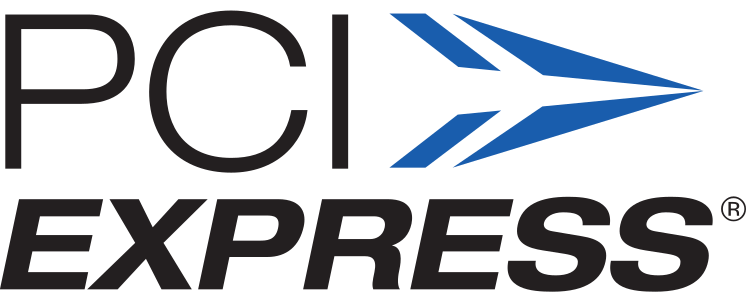PCI Express (PCIe) is a high-speed serial computer expansion bus standard designed to replace older bus standards such as PCI, PCI-X, and AGP. It is used for connecting high-performance hardware devices like graphics cards, SSDs, Wi-Fi cards, Ethernet adapters, and AI accelerators to a motherboard.
Overview
-
Full Name: Peripheral Component Interconnect Express
-
Initial Release: 2003
-
Maintained By: PCI-SIG (PCI Special Interest Group)
-
Latest Version: PCIe 6.0 (released in 2022); PCIe 7.0 (announced for 2025)
-
Key Features: High-speed data transfer, scalability, low latency, compatibility with older standards.
Technical Architecture
PCIe uses a point-to-point architecture with serial lanes rather than the shared parallel bus architecture used by PCI. Each lane consists of two differential signaling pairs: one for sending and one for receiving data.
-
Lane Configuration: x1, x2, x4, x8, x16, x32
-
Data Rate (per lane per direction):
-
PCIe 1.0: 250 MB/s
-
PCIe 2.0: 500 MB/s
-
PCIe 3.0: 1 GB/s
-
PCIe 4.0: 2 GB/s
-
PCIe 5.0: 4 GB/s
-
PCIe 6.0: 8 GB/s (with PAM4 signaling)
-
PCIe 7.0: 16 GB/s (targeted)
-
Each subsequent version has typically doubled the data rate while maintaining backward compatibility.
Key Components
-
Root Complex (RC): Interfaces between the CPU/memory subsystem and PCIe devices.
-
Switches: Allow multiple devices to communicate over a single PCIe interface.
-
Endpoints: The actual devices (e.g., GPU, SSD) that connect to the PCIe bus.
-
Bridges: Used to connect legacy PCI devices to PCIe systems.
Signaling & Protocol Layers
PCIe consists of three main layers:
-
Transaction Layer: Responsible for packet creation and addressing.
-
Data Link Layer: Ensures data integrity with error detection and retransmission.
-
Physical Layer: Handles actual transmission of bits over the wire.
Newer generations (like PCIe 6.0 and 7.0) adopt PAM4 (Pulse-Amplitude Modulation with 4 levels) signaling instead of traditional NRZ (non-return-to-zero) to achieve higher throughput.
Use Cases
-
Consumer PCs: High-performance GPUs, NVMe SSDs, and network cards.
-
Servers and Data Centers: Accelerators (e.g., NVIDIA GPUs, FPGAs), RAID cards, SmartNICs.
-
Embedded Systems: Industrial controllers, robotics, automotive infotainment.
-
AI and HPC Workloads: PCIe is critical for interconnecting GPUs and high-speed storage.
Form Factors & Interfaces
-
Add-in Cards: Standard x1, x4, x8, x16 slots found on motherboards.
-
M.2: A compact form factor often used for SSDs (e.g., NVMe drives).
-
U.2 and EDSFF: Interfaces used in enterprise storage systems.
-
CXL (Compute Express Link): An emerging interconnect built on PCIe 5.0/6.0 physical layer for memory coherency and AI acceleration.
Backward and Forward Compatibility
PCIe maintains software and mechanical backward compatibility, allowing newer cards to operate in older slots (with reduced speed) and vice versa, within physical and power constraints.
Power Management
PCIe includes Active State Power Management (ASPM) and supports various low-power states (L0s, L1, L2, etc.), making it suitable for mobile and embedded applications.
Comparison with Other Interconnects
| Interconnect | Max Bandwidth | Latency | Use Case |
|---|---|---|---|
| PCIe 5.0 | 32 GB/s (x16) | Low | GPUs, AI accelerators |
| Thunderbolt 4 | 40 Gbps | Medium | External devices |
| USB4 | 40 Gbps | Medium | Peripherals |
| CXL 3.0 | 128 GB/s (x16) | Ultra-low | Memory pooling, AI compute |
Future Roadmap
-
PCIe 7.0 (2025/2026):
-
512 GB/s aggregate bandwidth for x16
-
PAM4 signaling with higher energy efficiency
-
Further reduction in latency and support for AI/HPC applications
-
PCI-SIG and Ecosystem
The PCI Special Interest Group (PCI-SIG) governs the PCIe specification and includes members from across the semiconductor and computing industries, such as Intel, AMD, NVIDIA, Broadcom, Marvell, and others.
Challenges
-
Signal Integrity at Higher Speeds: Requires advanced PCB materials and layout.
-
Power Consumption: Particularly relevant for mobile and data center environments.
-
Latency Sensitivity: For real-time workloads and memory coherency, solutions like CXL are augmenting PCIe.













Quantum Computing Technologies and Challenges